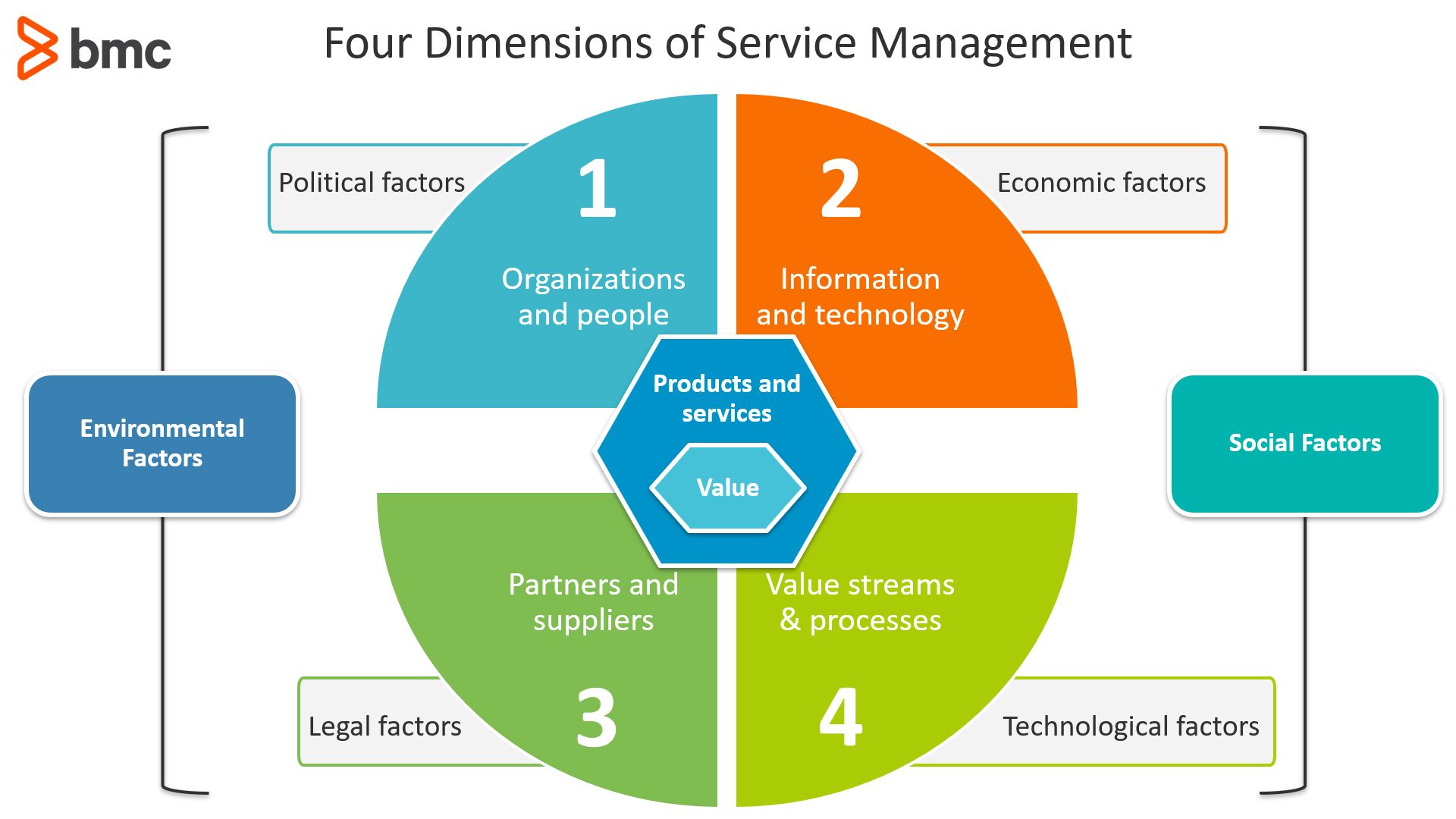To help their customers achieve their desired outcomes, organizations must take a holistic approach in the way services are conceptualized, developed, and managed.
ITIL® has defined four dimensions that collectively are critical to the effective and efficient delivery of value to customers and other stakeholders in the form of products and services. These dimensions are:
- Organizations and People
- Information and Technology
- Partners and Suppliers
- Value Streams and Processes
In this article, we’ll look at these four ITIL 4 dimensions. (This article is part of our ITIL 4 Guide. Use the right-hand menu to navigate to related articles.)
Download Now: ITIL 4 Best Practice e-Books
These all-new for 2020 ITIL e-books highlight important elements of ITIL 4 best practices. Quickly understand key changes and actionable concepts, written by ITIL 4 contributors.
Factors that impact the four dimensions
The four dimensions are synergistic, not independent. Insufficient focus on any single dimension will limit the value delivered by the organization to its stakeholders.
There are six environmental factors that may positively or negatively affect any or several or all of the four dimensions, and as a result they have to be considered from a risk management perspective. These factors, shortened to PESTLE, are:
- Political: Change in leadership within an organization, or in the locality where an organization exists can result in positive or negative sentiments towards an organization’s services or service management practices e.g. a government can come into power with a protectionism or open borders approach that may impact a company’s market share.
- Economical: Change in interest rates, gas prices or talent can result in an organization’s services being overpriced or unprofitable.
- Social: People’s preferences and perceptions change over time. Many organizations have a stakeholder base which spans a wide range of ages and demographic groups, and hence it can be difficult to to find a one-size fit approach in services and service management.
- Technological: Whether its AI, big data, crypto currencies or continuous delivery, the way services are created and delivered is hugely impacted by technology.
- Legal: GDPR has led to significant changes in the way service providers handle user data from a privacy perspective. At the same time, service delivery and access to services can be limited or enhanced through prevailing regulatory frameworks.
- Environmental: Climate change is impacting how organizations view their services and service delivery. Customers are becoming keen on purchasing services from companies that are seen to be respectful of the environment.

1. Organizations & People
People are the lifeblood of any organization that wants to remain relevant to its customers and stakeholders. People bring diverse skills, competencies, and culture, without which an organization cannot function. Despite the growth in use of machinery and technology, people are indispensable. For this reason, it is important to:
- Clearly define the roles and responsibilities
- Ensure reporting lines and communication channels are open and clear
- Establish a leadership framework to provide direction and oversight
The culture of an organization plays a significant role in how its day-to-day operations are carried out, how new staff members perceive the organization, and whether the organization is capable of transformation depending on environmental influences. A culture of blame can limit the effectiveness of practices such as problem management and continual service improvement. Hence all organizations should understand the prevailing culture, and take action to steer it towards the organization’s aspirations.
Skills are also very important in service management. Many organizations are choosing to invest in competence frameworks, such as SFIA and EU e-Competence Framework, to chart clear career development roadmaps for the roles that exist.
2. Information & Technology
According to a popular saying, “data is the new oil”. Data has become the lifeblood of most organizations, particularly where most business operations and service management activities are fully dependent on technology. Organizations are now coming to terms with the need to manage the lifecycle of information from creation, access, use, modification, storage to disposal, in order to maximize the value of the data in the delivery of technology services, while effectively managing the risks and obligations resulting from owning it.
Technology has played a big role in changing the way service management has happened globally. Collaboration and social media tools have increased the potential for co-creation of services, and enable greater awareness of customer needs, experiences and sentiments. Cloud services have made it easier for organizations to quickly deploy, scale up or tear down services in response to ever changing needs. The “Uber Economy” has created a new genre of services, underpinned by technology, which have disrupted previously dominant services delivered through more traditional, non-technical channels. Growth of new technologies such as AI and blockchain will ensure that service management will continue to evolve at a rate that is faster than ever experienced before.
Security has become key in how we manage information and technology, given the critical role they play as enablers in service management. As a result, the warranty aspects of services (i.e. availability, capacity, security and continuity) are increasingly determined by how information is managed and technology is used. In addition, technology architecture is increasingly critical for any organization wanting to get to grips with information across different domains and business units.
3. Partners & Suppliers
No one organization globally has the capacity to produce and manage the entire supply chain of its services or service management framework. Partners and suppliers play a vital role, and value is increasingly achieved through co-creation. An Internet Service Provider, for example, is a critical partner for any e-commerce business. At the same time, that ISP is dependent on utility companies, global carriers, providers of hardware and software, and many other organizations.
The relationship with partners and suppliers is usually defined based on what the organization needs. Some suppliers will be characterized as strategic due to their critical impact on services. In such cases, the relationship should be managed at a high level of leadership. Others are easily replaceable, as they operate at a commodity level. The organization, and its partners and suppliers, must have a common understanding of how their collaborative efforts delivers value through outcomes, and what is expected from both parties regarding value creation.
One of the ways organizations are managing their interactions with partners and suppliers is through a framework called SIAM (Service Integration and Management), which involves using an integrator to enact and manage common, coordinated processes across multiple partners and suppliers. This shields the end customer who only sees a single service delivery organization, rather than multiple providers. Service integration may be handled by the organization or outsourced to a partner or independent third party, depending on the needs of the organization.
4. Value Streams & Processes
The value streams and processes dimension is concerned with how the various parts of the organization work in an integrated and coordinated way to enable value creation through products and services. This dimension defines the activities, workflows, controls and procedures needed to achieve agreed objectives. What matters in service management is that an organization establishes an operating model that that effectively organizes the key activities needed to manage products and services.
Value streams
A value stream is defined as a series of steps an organization undertakes to create and deliver products and services to consumers.
Structuring the organization’s service and product portfolios around value streams allows it to have a clear picture of what it delivers and how, and to make continual improvements to its services. By mapping its value streams, an organization can identify what is critical, what introduces waste and what can be improved upon.
Processes
A process is defined as a set of interrelated or interacting activities that transform inputs into outputs.
Processes define the sequence of actions and their dependencies, as well as describe what is done to accomplish an objective. Processes are underpinned by policies and can be broken down further through procedures which outline what is done, when, and by whom.
Related reading
- BMC Service Management Blog
- Who Uses ITIL?
- ITSM Trends in 2020
- The State of ITSM
- People, Process & Technology
ITIL® is a registered trade mark of AXELOS Limited. IT Infrastructure Library® is a registered trade mark of AXELOS Limited.







